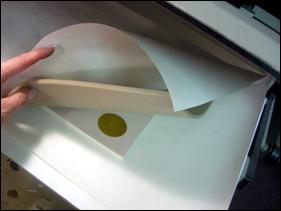 Photo 1
Photo 1
The mounting package is stacked bottom release paper, substrate, adhesive, letterhead with embossed seal (art), sponge foam, and top release paper.
Collectable documents, certificates, and children's art with three dimensional (3-D) elements continue to be popular items for framing. Some of these 3-D elements could be blind embossing, notary seals, sequins, or macaroni.
The best solution to mounting these may be to follow preservation techniques including hinges, corner pockets, or edge strips, but that may not always be what makes the customer happy. Sometimes there is an alternative.
Assume for the remainder of this article the item in question is indeed suitable for mounting, but that there is some 3-D element that precludes it from being traditionally dry mounted without crushing. The technique of sponge mounting is that of heat bonding in a dry mount press using traditional film or tissue adhesive with a protective sponge foam overlay. The sponge cushions the raised areas and prevents them from being crushed flat during mounting.
Wet, Spray and Pressure-Sensitive Mounting
Embossed (raised) and debossed (recessed) paper and 3-D items may be mounted a number of ways including wet glues, spray adhesives, and pressure-sensitive boards and films. The problem with these applications is the degree of permanency of the bond is directly related to the amount of applied even pressure during the initial mounting process. Any successful mounting technique includes the correct balance of time, temperature, pressure, and moisture (TTPM) and the very nature of an embossed seal or logo precludes excess pressure from being applied during the mounting process.
If wet gluing, the substrate is brushed or rolled with starch paste, adhesive, or PVA. Then the back of the art is lightly misted; then it would be aligned, covered and pressed with a rubber brayer to attach it to the backing board. The act of misting the back of the paper will soften, relax, and expand the fibers as it should, but then the rolling of the brayer over the surface of the cover sheet to affix it will likely flatten any embossing from the art.
When spray mounting the board is coated in two directions; allowed to evaporate during open time; then the art is aligned, pressed, and weighted to set. Once again the pressing process of using a hand roller will likely flatten the art. A manual pressure-sensitive film is usually first applied to the back of the art then the art is aligned onto the substrate. As above this would be difficult to achieve without damaging any embossing or notary seal.
A roller laminator might actually work with a sponge overlay if the tension between the rollers is adjusted to allow a sponge to be fed through with the art at just enough pressure to evenly bond, yet not flatten, the three dimensional portion of the image. The time invested in testing and then risking this for a one time mount precludes the profits surrounding the process, and opting for hinging might be best.
Dry Mounting
When using traditional dry mount techniques with any HA board, tissue or film, a 3-D image would also press flat as mentioned with the above mounting methods. But any raised surface piece may be dry mounted without fear when using the sponge mounting technique.
The thin overlay foam (aka sponge overlay) that is sold as part of the laminating package in a mechanical or hot vacuum press is the integral layer required for successful sponge mounting. The sponge should be the ¼" or ½" sponge available from laminate manufacturers. Do not use any other sponge alternate such as the thin sponge, often called craft foam, or upholstery foam rubber for furniture. Some sponges may have a higher degree of petroleum content in them that could outgas or stick to artwork. The other reason to use framing foam is size availability.
The sponge must cover the entire project not just the three dimensional portion of the art. This prevents an edge pattern or shape from being indented into a foam board substrate. The mounting package in this case is stacked (bottom to top) release paper, substrate, adhesive, letterhead with embossed seal (art), sponge foam, release paper (photo 1).
 Photo 1
Photo 1
The mounting package is stacked bottom release paper, substrate, adhesive, letterhead with embossed seal (art), sponge foam, and top release paper.
Press Adjustments
Since a vacuum press automatically adjusts to the thickness of anything being mounted, nothing needs to be manually adjusted to prepare for an added sponge layer. When the vacuum is drawn, the diaphragm conforms to the depth and shape of the substrate and creates even pressure against the heated platen. The sponge conforms to all the highs and lows of any embossing by filling and compressing around the design to protect it from being crushed under the pressure.
A mechanical press will probably require a slight adjustment to accommodate the additional thickness of the sponge layer during mounting. Prior to clamping the arm to the locked position, the closed arm of the press must be at 45 degrees to the table with all intended mounting layers having been placed in the press (photo 2). This will include substrate, art, sponge, and two layers of release paper. If the arm is greater than 45 degrees pressure it will be too tight and may crush the embossing. If it is less than 45 degrees, pressure is too loose and may not compress all the air from between the mounting layers.
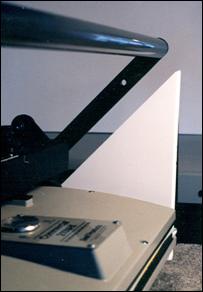 Photo 2
Photo 2
When the arm is closed but not locked it should be 45 degrees to the table when all layers of mounting thickness are inside. A 20x20" foam square scored diagonally and folded is a perfect template.
Sponge Mounting on an HA Board
Dry mounting permanence issues are resolved for valuable documents by selecting a reversible heat activated board like Bainbridge Restore, but there are technical issues surrounding sponge mounting to an HA board. With the adhesive coating covering the entire board surface if a 9 x12" certificate is flat mounted to the center of a 15 x 18" HA board the sponge will adhere to the exposed adhesive surrounding the certificate. So even though the embossed logo or notary seal looks great, the surrounding board will have been contaminated with sponge residue while the sponge itself may also be damaged, rendering it unusable for future mountings or laminating.
Since Restore is not a HA board recommended for fabrics or textural materials the sponge would easily peel from the foam board after mounting. But if the image is mounted to a permanent or removeable board such as: Bainbridge HAF, Single Step, Fome-Cor, HartMount, or Gilman Insite, the remaining sponge residue might be an issue when matting. Just think it through before sponge mounting on heat activated surfaces.
When to Sponge Mount
Original diplomas, certificates, and vellum should never be permanently mounted, as they are considered irreplaceable originals (photo 3). Also vellum and parchment sheets may be heat or moisture sensitive, and sometimes laser printed names can transfer off onto release paper. The actual logos, shields, embossing, seals, and otherwise decorative or gilded portions of these originals would tolerate sponge mounting, and with this process the dimensional aspects of these documents would look as good as they do unmounted.
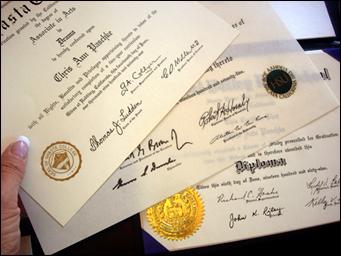 Photo 3
Photo 3
Original diplomas, certificates, and vellum should not be permanently mounted, as they are considered irreplaceable originals, but in theory the actual logos, shields, embossed, decorative and raised surfaces would all tolerate sponge mounting.
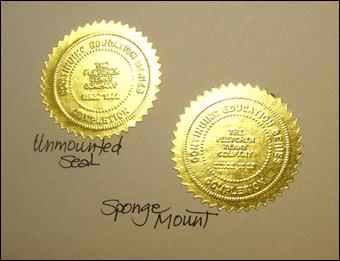 Photo 4
Photo 4
The gold p-s notary seal (L) from an old Fletcher Terry continuing education class has a nice degree of elevated embossing created from a hand held embossing tool The sponge mounted seal (R) has not compressed and even shows a slight bit of orange peel from the mounting process.
Gold and silver pressure-sensitive or water activated notary seals sponge mount perfectly with essentially no change to the embossed surface (photo 4). Sometimes a slight visual orange peel could result from the bond in the seal itself. Stationery, note cards, or envelopes with hand held blind embossing of corporate identity or monogram are perfect for sponge mounting (photo 5). Another perfect candidate for is the birth announcement, wedding invitation, or school graduation announcement (photo 6). These gems are keepsakes that tolerate mounting temperatures yet are often heavily embossed and may have foil accents or metallic inks. Traditional mounting would crush the school seal and embossed design, but the sponge will preserve all elements.
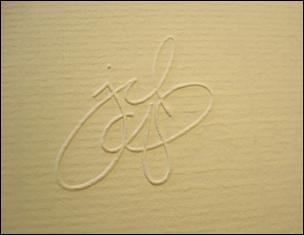 Photo 5
Photo 5
This double monogram (JCL-CAP) from a hand held embosser was imprinted on a corner sheet of fine stationery and was sponge mounted with no change.
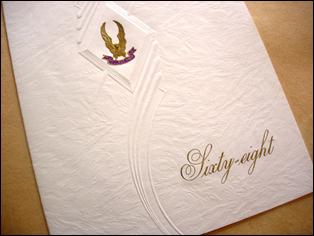 Photo 6
Photo 6
This graduation announcement is perfect for sponge mounting All inks, embossing and gold will tolerate heat and the sponge will not flatten it.
When Not to Sponge Mount
Even with the sponge mounting option, there will always be items unsuitable for the technique. Embossing is a technique of creating raised figures or shapes on paper, usually accomplished by pressing the paper from the back to imprint or project a raised design out the front. Debossing occurs when the paper is recessed or pushed away from the surface plane of the paper. A plate mark surrounding an inked etching is a perfect example (photo 7). It is the result of the paper being compressed against the inked printing plate to receive the art image. The compression is of such high pressure and the plate embossing is usually deep enough to be a candidate for sponge mounting, but the problem is that the recessed portion behind the inked art will bond well while the raised area surrounding it may not have maximum adhesive contact to the substrate. The sponge protects it fine, but the paper surface outside the printed etching is in peril of being compressed flatter. Even if the etching is not an limited edition, an alternative mounting method is recommended.
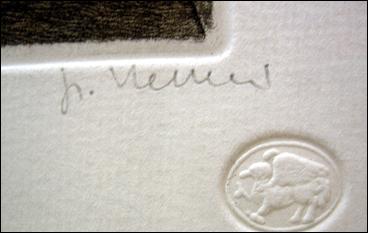 Photo 7
Photo 7
This corner detail of an etching plate mark and personal seal clearly show debossing, which is when the paper surface has be recessed back from the surface plane of the original paper. Not a good candidate for sponge mounting, even if it was an open edition.
Debossing is the result of letterpress printing where inked type is pressed into the surface of soft paper leaving not only the inked shape of the letter but an indented form (photo 8). Though letterpress would be protected by the sponge, this soft imprint may be a little delicate for mounting at all and would be better hinged (photo 9).
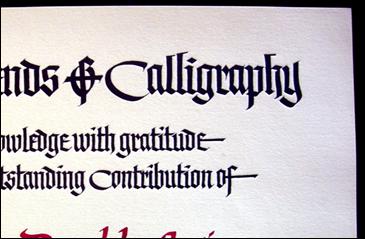 Photo 8
Photo 8
The ink transfer from individually set and inked type to the paper surface in letterpress creates a debossed compression of that paper surface during printing. Though difficult to see in this photo all the letters are slightly set back.
When both embossing and debossing are part of the art (paper raised and recessed) it is best to hinge the image. Though sponge mounting may work by cushioning the surface, the uneven nature of the back of the art will not likely mount evenly enough for a good bond, and it might compress the embedded shapes (photo 10).
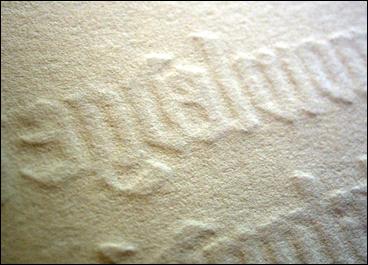 Photo 9
Photo 9
The back of the above printing better shows the debossed impression of the type. Though sponge mounting will protect this, the beauty of the print is in its dimensional life and it would be better if hinged.
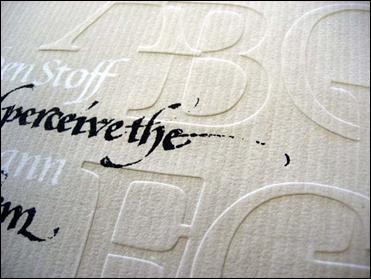 Photo 10
Photo 10
The letters B and E are debossed (recessed from the front) into the paper, while A, C and G are embossed (pressed forward from the back). Though the edges are hard and crisp with nice clean definition, mounting runs the risk compressing the layers and ruining the effect. Better to hinge.
Cast paper art is made of cotton paper fibers that are pored into a mold when the paper is initially being produced to create a three dimensional art image. In theory, paper castings could be mounted using the sponge method, but it would only be applicable with a low relief (photo 11). High relief or deep castings have too much dimension to be sponge mounted, because the added depth runs the risk of compression during mounting. Along with the four deckle edges this sample will be best showcased by float mounting with hinges (photo 12).
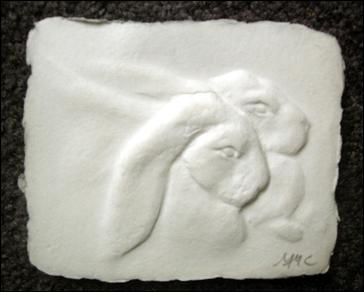 Photo 11
Photo 11
This low relief, soft edged, open edition, cast paper by MM Cooper would easily sponge mount without damage.
 Photo 12
Photo 12
This high relief, 1" deep, limited edition 12/500, carousel horse by MM Cooper is far too deep to be a sponge candidate. The essence of the art calls for a floated presentation.
It is common for vellum deeds and documents from the 1800s to have linen strips threaded through the pages then sealed with a wax stamp of notary. The depth and shape of the cloth and wax seal would easily tolerate being sponge mounted, but the wax itself should not be heated (photo 13). Many of these images are two sided pages from ledgers or are hand written documents, leases or deeds, which may require Mylar encapsulation to see both sides after framing.
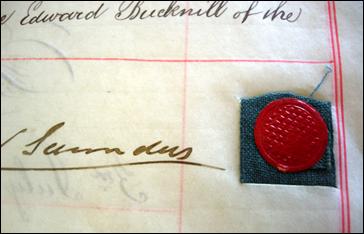 Photo 13
Photo 13
This original hand written Lease has entries from 1852 to 1899. A linen strip has been fed through the vellum and sealed with a red wax and notary stamp.
End Point
Learning any new mounting technique can be a wonderful, but limiting oneself to using it only when all the stars are in alignment is probably the best school of thought. And keep in mind that even if the newsprint, poster paint and handprint all tolerate the heat, and sponge mounting sounds like the best idea for a badly cockled original (photo 14), sometimes the end result leaves something to be desired (photo 15). Sponge mounting should never be the mount of choice for valuable originals, but when the school graduation announcement or wedding invitation arrives...well, there you go.
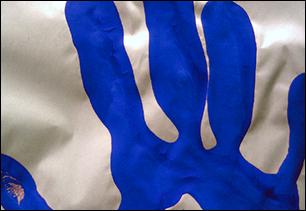 Photo 14
Photo 14
This cockled, unmounted, poster paint handprint on thin newsprint may be mounted. It is heat tolerant and may be compressed by the sponge to flatten it.
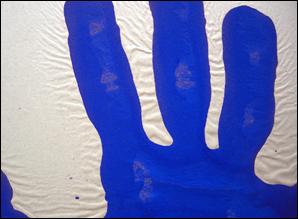 Photo 15
Photo 15
The mounted results of the handprint creates even compression creases surrounding all the fingers.
END
Copyright © 2007 Chris A Paschke
For more articles on mounting basics look under the mounting section in Articles by Subject.
Additional information on all types of mounting is found in:
The Mounting and Laminating Handbook, Second Edition, 2002,
The Mounting And Laminating Handbook, Third Edition, 2008 and
Creative Mounting, Wrapping, And Laminating, 2000 will teach you everything you need to know about getting the most from your dry mount equipment and materials as an innovative frame designer.
All books are available from Designs Ink Publishing through this website.
Chris A Paschke, CPF GCF
Designs Ink
Designs Ink Publishing
785 Tucker Road, Suite G-183
Tehachapi, CA 93561
P 661-821-2188
chris@designsinkart.com